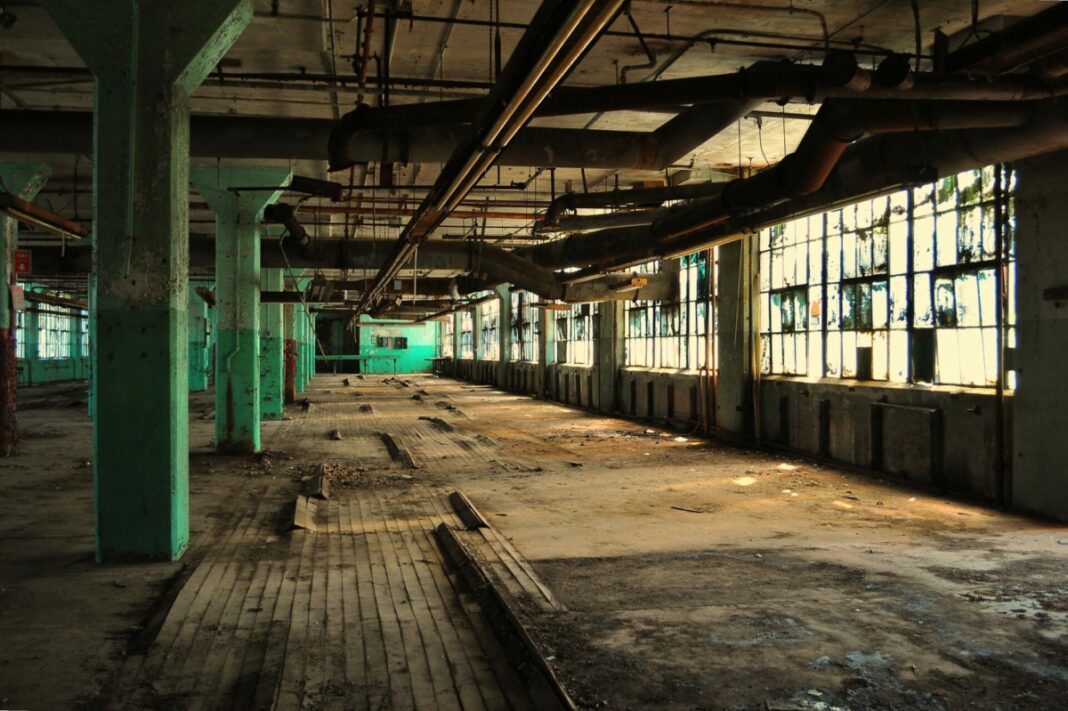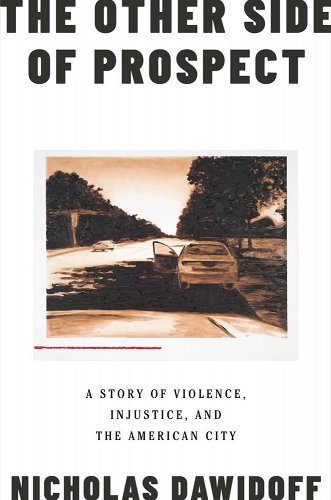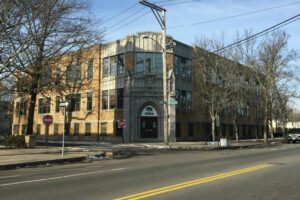Hamden, CT. What happens to a community built for workers when that work goes away? This is the urgent question writer Nicholas Dawidoff explores in his remarkable new book The Other Side of Prospect: A Story of Violence, Injustice, and the American City. (Full disclosure: Dawidoff is a friend and fellow resident of Hamden, CT.) The community that is the beating heart of Dawidoff’s work is the Newhallville neighborhood of New Haven, whose physical and psychic separation from the hallowed halls of Yale University by Prospect Street provides the book its title. And yet as Dawidoff makes clear from the outset starting with his choice of subtitle, the challenges facing Newhallville also confront places all over the country where working-class people could once raise a family through the sweat of their brows but now no longer can. While The Other Side of Prospect is very much a Newhallville story, it is also an American one.
Newhallville’s version of the American story begins in 1849, when George Newhall located his carriage manufacturing business on railroad-adjacent farmland outside of New Haven’s downtown business district. With over two hundred employees in need of a place to live, Newhall took a page from earlier Connecticut industrialist Eli Whitney (father of the Whitneyville neighborhood) and built a community for his workers complete with “churches, a school, and a horse-drawn trolley to the city center.” While the advent of the automobile ultimately doomed the carriage trade, Newhallville’s residents had already found another industry eager for their labor—gun makers. In 1871, the Winchester Repeating Arms Company moved its operations to land near Newhall’s carriage factory.
For the next century, this legendary manufacturer of “The Gun That Won the West” and the neighborhood that housed most of its workforce grew in tandem. Migration fueled this growth, with “each new misery of elsewhere creating the latest Irish, then Italian, then Russo-Polish wave willing to endure grinding labor and crowded, inexpensive conditions as the newcomer’s dues.” These dues having been paid, future generations could look forward to better opportunities. In Dawidoff’s evocative description, “[e]verybody knew of families where the grandparents from Ireland met in Newhallville at a County Kerry party, worked at Winchester, bought a house on Shelton Avenue, had kids who lived in a Hamden ranch house, who, in turn, had kids who earned graduate degrees, ended up commuters out on the tony shoreline.”
As a result of surging demand for armaments workers during World War II, Winchester belatedly began offering a foothold to a new type of migrant—African Americans fleeing the Jim Crow South as part of the Great Migration. The integration of Black workers into the previously segregated Winchester and its company neighborhood produced significant pushback from white employees and residents. Winchester itself typically shunted African Americans into the dirtiest, most dangerous, lowest paying jobs available. And yet for those who proved themselves in these roles, there would be the chance to learn a trade. As Newhallville became an increasingly African American neighborhood—from 3% Black in 1950 to more than 90% just three decades later—the ability to find work at Winchester provided a degree of prosperity. The Newhallville neighborhood of the 1960s was, in the words of one resident quoted by Dawidoff, “the most risen, solid Black neighborhood.”
The good times didn’t last. By the 1970s New Haven would lose half of its factories and two-thirds of its manufacturing jobs. Winchester, which had employed almost 14,000 people during World War II, trimmed its payroll to just 1,400. What came next will be familiar to anyone who has read William Julius Wilson’s When Work Disappears. With so many people in Newhallville out of work, the ecosystem of “breakfast counters and taverns, barber and dress shops, the doctor’s and dentist’s offices” that Winchester paychecks had previously supported dried up. Residents went from not locking their doors to chaining their front hoods shut to prevent the theft of car batteries. Substance abuse and the drug trade that feeds off it took hold. By the time Winchester finally shuttered its factory for good, crack cocaine had become “a third manufacturing boom in Newhallville, a predatory successor to carriages and rifles.” In the cruelest irony of all, the withdrawal of an iconic American firearms manufacturer resulted in an explosion of gun violence.
Dawidoff brings this sad decline to life through the interconnected stories of three residents: an elderly grandfather murdered on the streets of Newhallville in 2006 (Herbert “Pete” Fields Jr.), the sixteen-year-old boy wrongfully imprisoned for his killing (Bobby), and the teen who likely committed the crime (Major). Long before his murder, Pete Fields had followed the “out-and-up” pattern of life in Newhallville during its heyday. After migrating with his family from South Carolina to New Haven as a teenager in 1951 without so much as a winter coat, Fields moved to neighboring West Haven in 1964 and bought a home. Such were his ties to the close-knit Newhallville of his youth that he remained a frequent visitor. Using a beloved Newhallville social club known as the Mudhole as his base of operations, Fields often cooked meals for down-on-their-luck club members or took needy families out for Christmas shopping sprees.
By the time of Bobby and Major’s youths, Newhallville looked much different than it had during Fields’ upbringing. Coming of age in a community that had become short on stability and hope, Bobby and Major ultimately responded in very different ways. Devastated by the death of his mother during his childhood, the once promising Major became a stickup kid and later a paid assassin before he himself was eventually murdered. According to a New Haven police officer who had known Major since he was young, “[a] lot of people saw him as a cold-blooded killer. He didn’t start off that way.”
For Bobby, a desire for experience of the wider world resulted in long, solitary bike rides around New Haven starting at the age of nine. Travelling across the Prospect Street divide, he became keenly aware of the stark contrasts between his neighborhood and the rarified air of Yale. “Come over that hill, it’s a whole different reality,” he tells Dawidoff. Although exposed to unrelenting violence in the neighborhood, Bobby remained uninvolved. In the language of the streets, Bobby was “just around,” the term applied to someone not caught up in drug trafficking or other criminality. Bobby would watch neighborhood kids burst into convenience stores and make off with shoplifted items before paying for his own purchase. None of this prevented Bobby from becoming the focus of a slipshod investigation by unscrupulous police detectives increasingly determined to pin the murder of Pete Fields on him despite all evidence to the contrary. The unfolding of the injustices that resulted in Bobby’s wrongful conviction and the legal crusade that it took to finally free him after nine long years makes for reading that is as infuriating as it is page-turning.
The strength of Dawidoff’s book is in his ability to render Newhallville and its residents in all their fullness. Dawidoff spent eight years reporting The Other Side of Prospect and it shows. Whereas far too many outside chroniclers of neighborhoods like Newhallville focus almost exclusively on the hardships they face, Dawidoff provides a more complete picture. We get to know community members not just as perpetrators and victims, but as people. We learn not only about Newhallville’s current challenges, but also its continued resilience. This resilience is particularly on display in the case of Bobby, who even after his release from prison is repeatedly knocked down but always finds a way to get back up.
For some, the answer to the loss of good jobs in places like Newhallville is labor mobility. (I once had a colleague at Yale ask in all sincerity why everyone in Appalachia doesn’t just move to West Texas). And Newhallville’s own history may seem to point to such mobility being a fact of life. Successive waves of migrants came to the neighborhood from all over Europe and later the Deep South in search of better lives. If they all had to leave home to thrive, why should the current residents of Newhallville be any different? Yet even if such uprooting were an attractive solution, The Other Side of Prospect calls into question whether it is still a practical one. As Dawidoff notes, the type of migration that populated Newhallville was historically made possible by strong community and familial bonds:
A truth of the Great Migration was that the first generation self-selected for ambition and initiative. They tended to be young, strong, better-educated, often married people who had the backing of other family members who sometimes pooled their money to help them go. It was a chain migration, where each family that went north was a fillip for other families to pick up and do the same.
New arrivals could often count on an extensive support network of kinfolk and former neighbors who could help them get settled, by providing, for example, a temporary place to stay or a lead on a job. In today’s increasingly atomized society, it is not clear that such support networks would still exist to ease migrants’ way. As compared with this support, the government-issued relocation vouchers that modern-day proponents of labor mobility frequently tout seem a pretty thin gruel. And given that the loss of good working-class jobs is an American problem and not just a Newhallville one, it is unclear where residents would even go.
What might it look like to try to support postindustrial working-class communities where they are rather than to destroy them in order to “save” them? For Dawidoff, a national problem of this magnitude and intractability calls for the engagement of our country’s great institutions. Deindustrialization is “too big a problem for small neighborhood organizations to solve, too big a problem for mayors with lean budgets, daily governance, and two-year terms.” Unfortunately, these institutions have not answered the call. Dawidoff notes ruefully that despite being in Newhallville’s literal backyard, Yale has no institute for postindustrial studies dedicated to tackling the question of what to do about working-class neighborhoods without any work.
Certainly there is a need for a national conversation and national solutions on everything from trade policy to labor relations to our underinvestment in career and technical education. But reading The Other Side of Prospect, one is left with the sense that the ultimate authors of Newhallville’s future revitalization, if it is to occur, will be its community members. Create the conditions in which they can succeed and watch them bring to the task all of the grit and determination that have been the hallmark of Newhallville residents for generations.
Image Credit: “Abandoned Winchester Arms Factory,” photo by Jack Parrott














